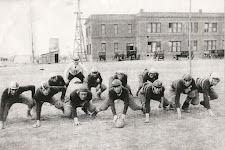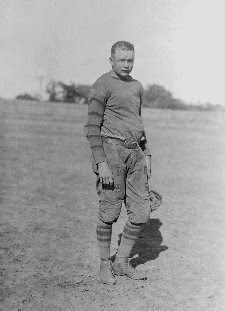 |
| Buster Welch today. (Photo from The Cut website) |
Mr. Welch is a member of the National Cutting Horse Association, American Quarter Horse Association and Texas Cowboy Hall of Fame. He and his horses have won five NCHA Futurity titles and four NCHA World Championships. He has also been honored over the years with several other awards including the Western Horseman Award and the American Cowboy Culture Working Cowboy Award. In 1962, he was instrumental in establishing the NCHA Futurity at the Nolan County Coliseum in Sweetwater, and in 2012, he received the National Golden Spur Award for his “outstanding contributions to the ranching and livestock industry.”
On May 12, 2018, he was honored by the City of Roscoe with a Buster Welch Day on the occasion of his 90th birthday.
Now 91, he is still working cattle on horseback. His four children, Ken, Ruth Ann, Greg, and Georgia, all went to Roscoe schools and graduated from Roscoe High.
He is featured in a nice article in the latest issue of Quarter Horse News about the honor, the statue unveiling, and the artist who made the statue. It is accessible online by clicking here.
He will also be featured in an upcoming documentary about cutting horses entitled The Cut: The Story of America’s Greatest Horse. The new trailer for the film below has just been released with new interviews and footage. To view it, click the play button.
--o--
PLOWGIRLS FALL TO JAYTON 51-27
The Lady Jaybirds proved to be too much for the Plowgirls in Jayton last night, defeating them 51-27. Shauna McCambridge had a good night, though, making 5 of 7 field goals, 3 of 4 free throws and getting 8 rebounds.
Scores by quarters:
Jayton 14 25 42 51
Plowgirls 6 10 17 27
Individual Plowgirl scoring: Shauna McCambridge 13, Cameron Greenwood 6, Kaylea Perez 4, Layla Herrera 2, Mia Lavalais 2.
Next up for the Plowgirls is the Highland Tournament which runs from Thursday to Saturday. The Plowgirls JV will participate in a JV Tournament in Bronte Saturday.
--o--
ROSCOE IN YEARS GONE BY: EARLY SCHOOLS
 |
| Bernecker School, ca. 1980. |
Country people often made sacrifices so that their children could go to school there. For example, in 1894 Joe Nunn sold his Thin Branch ranch northwest of Roscoe and moved to town so his children could attend the school, and, later, the Arledges, who owned the 69 Ranch south of Roscoe had a house built in town so their daughters could live there and go to school. When buying farms, people often considered their proximity to a school for their children.
Roscoe wasn’t an incorporated city in 1900, so the census taken that year doesn’t indicate how many people lived there. But it was in Nolan County’s Precinct 5, which had 55 heads of household and a population of 296. Between 1900 and 1910, however, the population around Roscoe boomed as more area farmland was purchased and put into cultivation. The 1910 census lists 2,829 people in Precinct 5 and 972 in an incorporated Roscoe.
The country schools sprang up because children needed to live close enough to walk to them. A few rode in buggies, and some went on horseback, and, in at least one case, there was a wagon that picked kids up—the Champion “school bus,” which was a “horse-drawn wagon with a top and rows of benches along the sides” (100 years, p. 325). Some kids didn’t go to school at all because they lived too far away to walk, and kids from farm families didn’t go to school during cotton harvest because they were busy picking cotton. For that reason, the schools were in session only seven months of the year or less, starting in November when picking season was over. The teachers were usually single young women who lived with families near the schools and were paid little for their work, and most of the country schools began as one-room schools.
The Roscoe school served the town as well as families living three and four miles away. According to R. E. Gracey, “Sometime as many as 20 children walked with them [i.e., the Gracey kids] on their way to school,” probably because the Gracey farm, just southwest of town, was close to the school, and children living farther out crossed it on their way. He also notes that even in town, teachers and children acted as their own janitors and were not able to maintain school for nine months.
The first country school in the area was the Brownlee school, five miles west of town, established in 1901. The following year, the Champion school began six miles southwest of town, and others followed in the next few years: Mesquite, nine miles southwest; Barnett, four miles south of Mesquite; Goode, four miles southwest; McBurnett, six miles southeast; Blackland, five miles northeast; and Bernecker, seven miles north. Wastella, originally the Richardson school, moved one mile north to Wastella in 1908 after the Roscoe, Snyder & Pacific railway was built. Fairview was north of Brownlee and east of Wastella, and Pyron was 11 miles northwest of Roscoe.
These country schools all lasted three or four decades and taught a varying number of grade levels, up to as many as nine at Brownlee. Students who wanted to go beyond the highest grade level at their school provided their own transportation to the closest high school, usually Roscoe.
Most of the country schools grew as more people settled in the area, and some that began with one room grew into three and four-room schools in the 1920s and ‘30s. These included Goode, Brownlee, Maryneal, Wastella, and Champion, and Pyron was large enough to have a high school.
As roads from farms to schools got better and transportation improved, consolidation became possible. Once schools were able to bus students, the country schools with their short terms and mixed grades gave way to the larger, better organized and better funded schools.
Highland School was formed in 1935 from the country schools of Champion, Barnett, Mesquite, Maryneal, and Goode. Fairview school consolidated with Roscoe around 1930 while Blackland, Wastella, Brownlee, and Bernecker all consolidated with Roscoe in the late 1940s, while Pyron’s school district was split between Roscoe and Hermleigh.
As a result of the consolidation, Roscoe’s school district expanded to 221 square miles with 98 of them in Nolan County, 67 in Mitchell County, 33 in Fisher County, and 23 in Scurry County.
Editor’s note: For more details concerning the schools and some of the families that attended them, see First 100 Years: Nolan County Texas. Dallas: Taylor Publishing, 1983, pp. 42-63.
--o--
WEATHER REPORT: RAIN, FOG, NICE WEATHER
 |
| Sunday's sunrise. |
The temperatures on both Wednesday and Thursday were cool with highs of 46° and 43° and lows of 32° and 34° respectively. Friday and Saturday were warmer with highs of 62° and 64° and lows of 41° and 45°. Sunday was a bit cooler with a north breeze and a high of 53°, but Monday was back up to 62° and yesterday to 65°. The mornings have been cool, but the weather has been nice for the past few days, and it’s been a pleasure to be outside in the afternoons.
Today and tomorrow should be even warmer with the temperature rising to 70° this afternoon and 76° tomorrow. The south wind will be light today, but stronger tomorrow as it shifts to the southwest. On Friday, it will be from the north, making for a high of only 53° Friday afternoon. But then the weekend will be partly cloudy and warmer with highs of 62° Saturday, 71° Sunday, and 65° Monday.
Rain is not in the forecast.
--o--










Really interesting report on all the small country schools in the Roscoe area. There's lots of forgotten history in these that has "gone with the wind". Another time, another place.
ReplyDeleteCongrats to Buster Welch - a genuinely nice guy. I have many fond memories of him and his children who I drove to and from school in the "little bus" during many years. Loved fishing and hunting arrowheads on the 18 Ranch as well.
ReplyDeleteThis comment has been removed by a blog administrator.
ReplyDeleteThis comment has been removed by a blog administrator.
ReplyDelete